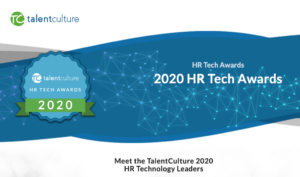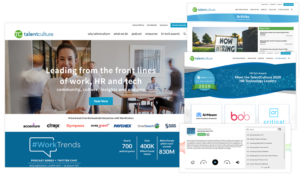
Congratulations to the Winners of TalentCulture’s 2020 HR Tech Awards
The dust has settled. We’ve counted the votes. And the final rankings are set… The winners of TalentCulture’s 2020 HR Tech Awards are here! To

The dust has settled. We’ve counted the votes. And the final rankings are set… The winners of TalentCulture’s 2020 HR Tech Awards are here! To

If we’ve learned anything over the past decade, it is the power of a hashtag… #WorkTrends has been on quite an adventure. Over the past

We’re thrilled to announce that our newly revamped website is now live! In keeping with our mission, it offers the insights that empower HR, the

New state and local laws addressing pay equity make salary disclosure illegal. Does your company know how to navigate these new policies?

The right partnership is key for successful performance management. Here are some expectations you should set for consultants you work with.

Everyone wants to improve their performance management, but doing it isn’t that easy. Meghan M. Biro looks at the key reasons we fail and how to succeed. It’s all about the tech.

HR tech is undergoing dramatic change—from the shift to mobile and the explosion of analytics and artificial intelligence, to new software options and the emergence

Hiring is a fact of business for companies, whether it be a consistent part of their process or an occasional effort. The one thing for
Robots are taking over the World. Well, no not really. But something that is going to be a game changer is about to take over
Have you noticed how popular video has become? It just keeps growing in popularity! Do you use video in your workplace? Well, if you want
Most of us want people to like us, especially in social settings, but sometimes the idea of going out there and schmoozing seems phony and
Join host Meghan M. Biro and special guest Michelle Lederman as they discuss “The 11 Laws of Likability.” During this lively conversation, they’ll talk about
I recently attended a talk on personal branding given by Dorie Clark, bestselling author of “Stand Out,” at the Library of Congress in Washington D.C.
Thousands, maybe even millions of research articles flood the web on how Xers and Boomers are trying to understand what millennials really want in the
The TalentCulture #TChat Show is back live on Wednesday, February 3, 2016, from 1-2 pm ET (10-11 am PT). Last week we talked about how
Last week we talked about how tech professionals can help assess and hire other tech pros, and this week we discussed how HR leaders can
TalentCulture and #TChat. The evolution of a successful Twitter chat… Meghan M. Biro and I have done something amazing here, something we are so very
Satisfying your customers isn’t good enough in today’s competitive markets. Meeting their needs falls short of earning their loyalty. You need to dazzle them; leave
A huge 75% percent of people that quit their jobs, do so because of their bosses. At the same time, employers cite high staff turnover as
Silicon Valley is home to some of the world’s most successful tech businesses, all offering bigger and better perks than most of us could dream

The TalentCulture #TChat Show is back live on Wednesday, June 10, 2015, at its new time from 1-2 pm ET (10-11 am PT). Last week

This week we were joined by Mark Stelzner, Founder of IA HR, a consulting firm that helps HR leaders transform their organizations with confidence. This

Old school leadership is about control and pushing people to achieve results; setting and communicating objectives; delegating tasks; measuring results. Nothing wrong with old school,
Performance wanes. Employee engagement falls and morale sinks. These are tell-tale signs that your culture is sick and needs attention. So how do you go
The balance of power is shifting in the employer/employee relationship. What does it mean for the future of work? The #TChat crowd weighs in